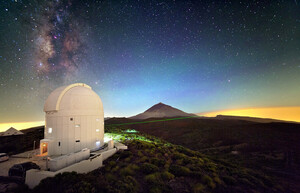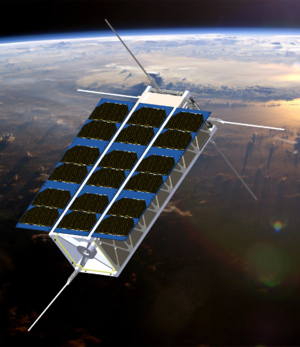The longest-standing research area of the Ursin group is free-space quantum communication. The first milestones were reached in the late 2000s, when Rupert Ursin et al. showed QKD over a 144km link in the Canaries. More recently, we have deployed real-world intra-city links with our very own ground station on the institute’s rooftop, and even satellite connections.
Satellite QKD
The only way to establish a quantum connection over a distance of more than 300 kilometers is the deployment of satellites. In a collaboration with the Chinese Academy of Sciences, the Ursin group realized the first intercontinental quantum key distribution by exchanging a quantum signal with the Chinese satellite Micius [1]. Using this key, the first intercontinental quantum-secure telephone call was held between China and Austria on 27th September 2017.
CubeSats
The development, launch and maintenance of large-scale satellites is extremely expensive. An cheaper alternative, especially for scientific missions, is the deployment of small nanosatellites, so-called CubeSats, which are around the size of a shoebox. The Ursin group has used its expertise for several design studies in collaboration with satellite experts: The Q³Sat [2] and the NanoBob [3] as receiver satellites and also a CubeSat sender mission [4].
Entanglement in high dimensions
Quantum optical links through air can suffer from turbulent atmosphere and adverse weather conditions. It is therefore desirable to encode as much quantum information as possible in the photons sent. This can be done by using more than one of the photon’s degrees of freedom, e.g. polarization and creation time. The Ursin group demonstrated this for the first time in 2017 over a 1.2 km link in Vienna [5]. An extension of the experiment with emphasis on noise resilience was carried out in 2019 [6].
[1] S.-K. Liao et al., “Satellite-Relayed Intercontinental Quantum Network,” Phys. Rev. Lett., vol. 120, no. 3, 2018.
[2] S. P. Neumann et al., “Q3Sat: quantum communications uplink to a 3U CubeSat — feasibility & design,” EPJ Quantum Technol., vol. 5, no. 1, p. 4, Dec. 2018.
[3] E. Kerstel, A. Gardelein, M. Barthelemy, M. Fink, S. K. Joshi, and R. Ursin, “Nanobob: A CubeSat mission concept for quantum communication experiments in an uplink configuration,” EPJ Quantum Technol., vol. 5, no. 1, 2018.
[4] D. K. Oi et al., “CubeSat quantum communications mission,” EPJ Quantum Technol., vol. 4, no. 1, p. 6, 2017.
[5] F. Steinlechner et al., “Distribution of high-dimensional entanglement via an intra-city free-space link,” Nat. Commun., vol. 8, no. May, pp. 1–7, 2017.
[6] S. Ecker, L. Bulla, R. Ursin, and M. Huber, “Entanglement distribution beyond qubits or: How I stopped worrying and learned to love the noise,” Prep., 2018.



